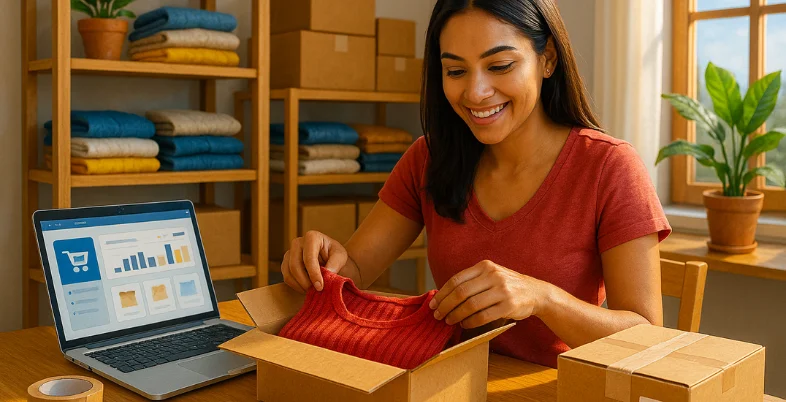Have you been thinking of owning a business with minimum investment and little risk involved? The perfect way out could be dropshipping. As the e-commerce trend grows in India, more entrepreneurs are looking to start a dropshipping business in India, a model that lets you sell products online without having to hold any inventory.
Rather, you concentrate on marketing and sales as your supplier delivers his goods right to your customers.
Getting a dropshipping business going in India has never been so easy as now, starting with the efforts required to establish your online shop to locating the proper suppliers. Here, this guide will lead you through the steps so that you can start your venture successfully.
What Is Dropshipping?

With the dropshipping business strategy, you may sell products online without having to handle or stock up on products. You don’t stock up on supplies or purchase them in bulk. You collaborate with third-party suppliers (e.g., manufacturers, wholesalers, or retailers), who deal with warehousing, packaging, and shipping.
The primary work of a dropshipper is to manage an online shop, promote the items, determine the prices, and provide customer support. When a customer places an order on your website, the supplier will fulfill the order and ship the item to the customer.
This low-investment model allows a beginner in the eCommerce business because it discards the overhead costs and the risks in conventional retail.
Why Is Dropshipping A Well-Liked Business Strategy In India?
1. Low Costs Of Start-Up
Cheapness is one of the greatest merits of dropshipping. Inventory, warehousing and shipping are usually facilities requiring massive investment in traditional businesses. Dropshipping eliminates the requirement for inventory purchases and upkeep. This qualifies it as a superb option among newbies that wish to begin small and expand over time. The problem is that all you need is a website, a market niche, and reliable vendors.
2. Low Risk Business Model
Dropshipping enables you to experiment with various products without putting yourself under any financial risks. Since you only have to pay when a consumer places an order, you are not obligated to purchase goods that you might not sell. When a certain item fails to do well, it is very easy to discard it in your store to a different one. Such a versatility enables you to adjust fast to the preferences of customers and market trends.
3. High Flexibility
It is one of the most desirable features of dropshipping because you can work remotely. Just a laptop with internet connection is all you require. Online drop shipping is flexible and you can work around it based on your availability whether you are a drop shipping student or working professional or a stay-at-home parent. You control time and business activity to a hundred percent.
4. Easy Scalable
Processing larger volume of orders does not necessitate the need to hire additional personnel or to accommodate a larger warehouse because your dropshipping business is expanding. All the logistics are taken care of by your suppliers and you can scale up without adding more workload to yourself. This is what makes dropshipping very scalable to individuals who need to have a bigger eCommerce operation.
5. Broad Product Line Variety Of Products
With dropshipping, you may offer a variety of goods without having to purchase each one. It is simple to experiment with new categories or act with the trend without the danger of overstock.
6. No Inventory Required
You do not have to spend time and energy on inventory management since your suppliers will handle the packaging and delivery for you. With the help of inventory management software, this process becomes even more streamlined, allowing you to focus your time on marketing and customer service—areas that have a direct impact on your sales and profits.
What Is the Price to Begin Dropshipping In India?
Compared to typical enterprises, it is quite inexpensive to start a dropshipping business in India. Renting a store or making inventory investments are not necessary. The basic costs include buying a domain name and hosting, which can cost around ₹1,000 to ₹3,000 per year. The monthly cost of using Shopify is approximately ₹2,000.
Marketing is important in dropshipping, and you can start with a budget of ₹5,000 for paid ads on Google or Facebook. Payment gateways in India also charge a small fee per transaction, usually 2-3%. Starting a dropshipping business in India might cost anywhere between ₹20,000 and ₹50,000.
The exact amount depends on your choice of platform, tools, and marketing strategy. Using AI dropshipping tools can also optimize product selection, automate tasks, and improve customer experience, making your operations more efficient. With proper planning, dropshipping offers a low-risk way to enter the world of online business.
Is Dropshipping A Profitable Business?

Yes, dropshipping is a great business to venture into and also thrives well at the beginner level, where one wishes to start with little investment. Because you don’t need to purchase inventory or have storage space to hold it, your overhead expenses are minimal. The main portion of profitability depends on choosing the niche, clever pricing of products, and genuine marketing campaigns.
Although the profitability of individual products can be lower than conventional retail, you can ramp up with the appropriate approach. It takes two to three things to have a successful dropshipping business: trending products, high-quality customer service, and constant work on your online store.
How To Start A Dropshipping Business In India?
1. Select Proper Niche
Choosing the niche is perhaps one of the critical procedures involved in launching a dropshipping venture. Find those items that are needed, that are not heavily competitive, and that have high profitability. Do not go into super competitive markets. Choose the niche that you are passionate about or know more about—it will be easier to market and deal with the customers, especially when selecting the right dropshipping products to sell.
2. Locate Good Suppliers Group
The performance of your overall company will lie in the efficiency of the suppliers in the movement of inventory and delivery. Consider AliExpress or Oberlo, or use dropshipping suppliers in India for faster and more localized fulfillment.
When buying from suppliers, a sample check is always advisable. Test communication, product quality, and delivery timelines. Long-term success requires you to establish good relationships with your suppliers.
3. Design An Easy Online Store
You can set up a dropshipping store with the help of e-commerce platforms for dropshipping such as Shopify, WooCommerce, or Wix. Be certain that it is a user-friendly, mobile-friendly, and secure location. Make good-quality product photographs and descriptions. The business face of your company is your store; you must be professional and have a name that one can trust.
4. Specialization In Digital Marketing
As dropshipping is a competitive market, marketing is of the essence. To popularize your products, use such social media as Instagram, Facebook, and YouTube. Take a lesson in paid promotion, SEO, cooperation with influencers, and email communications to bring people to your store. A competitive edge will be consistent branding and exciting content.
5. Provide Super Customer Service
The success of your dropshipping business can either be built or broken by customer satisfaction. Be timely in responding to queries and complaints. Use easy-to-understand tracking and returns policies. Satisfied clients are more willing to write reviews and tell their friends about your store.
6. Monitor And Analyze Performance
Try to use the capabilities of such tools as Google Analytics, Facebook Pixel, and Shopify Analytics to track your store. Keep on track of the products that sell most and also what drives your traffic and the conversion rates. Use data to make decisions about your store and marketing.
7. Keep Abreast With Trends
The online business world develops rapidly. Visit industry blogs, join groups specializing in dropshipping, and enroll in online courses to be in the know. Responding to the trends in the market and the behavior of clients is crucial in remaining ahead in the dropshipping game.
Ending Note
If you want to do e-commerce without making huge initial investments, opening a dropshipping business in India is a great idea. With a proper niche selection, a healthy supplier base, and successful promotion, you should be able to create a sustainable company.
Keep in mind that you won’t be successful immediately—consistency and a well-developed strategy will make your online store a successful project. Keep up with trends, make your store as good as possible, and continue to learn. Now that you understand how to start a dropshipping business in India, get to it and put your business plan into action. It is a new adventure you begin today!
FAQs
1. Is It Legal to Dropshipping India?
As far as India is concerned, dropshipping is not illegal at all. But you still have to be in accordance with Indian tax regulations, i.e., registering for GST once your turnover exceeds the limit, and be equally front-of-house with the clients.
2. Does Selling Dropshipping in India Require a GST Number?
Although it is possible to begin without it at first, it is recommended to obtain a GST number in case you want to scale the business or install paid advertising, as it is needed by numerous payment gateways and platforms.
3. Which Platforms are the Most Suitable to Open a Dropshipping Store?
The most popular ones are Shopify, WooCommerce, and Wix. Shopify is easy to use and provides extensive dropshipping applications, whereas WooCommerce is highly customizable.
4. Where Do I Get Dropshipping Suppliers In India?
Indian suppliers can be located on GlowRoad, Baapstore, or Indiamart or through dropshipping apps using Shopify or WooCommerce.
5. What is the Time Frame to Make Money in Dropshipping?
It depends on your pricing, promotion, and niche. Some enterprises make sales in weeks, and others profit in a few months. Testing and consistency are the most crucial factors.

